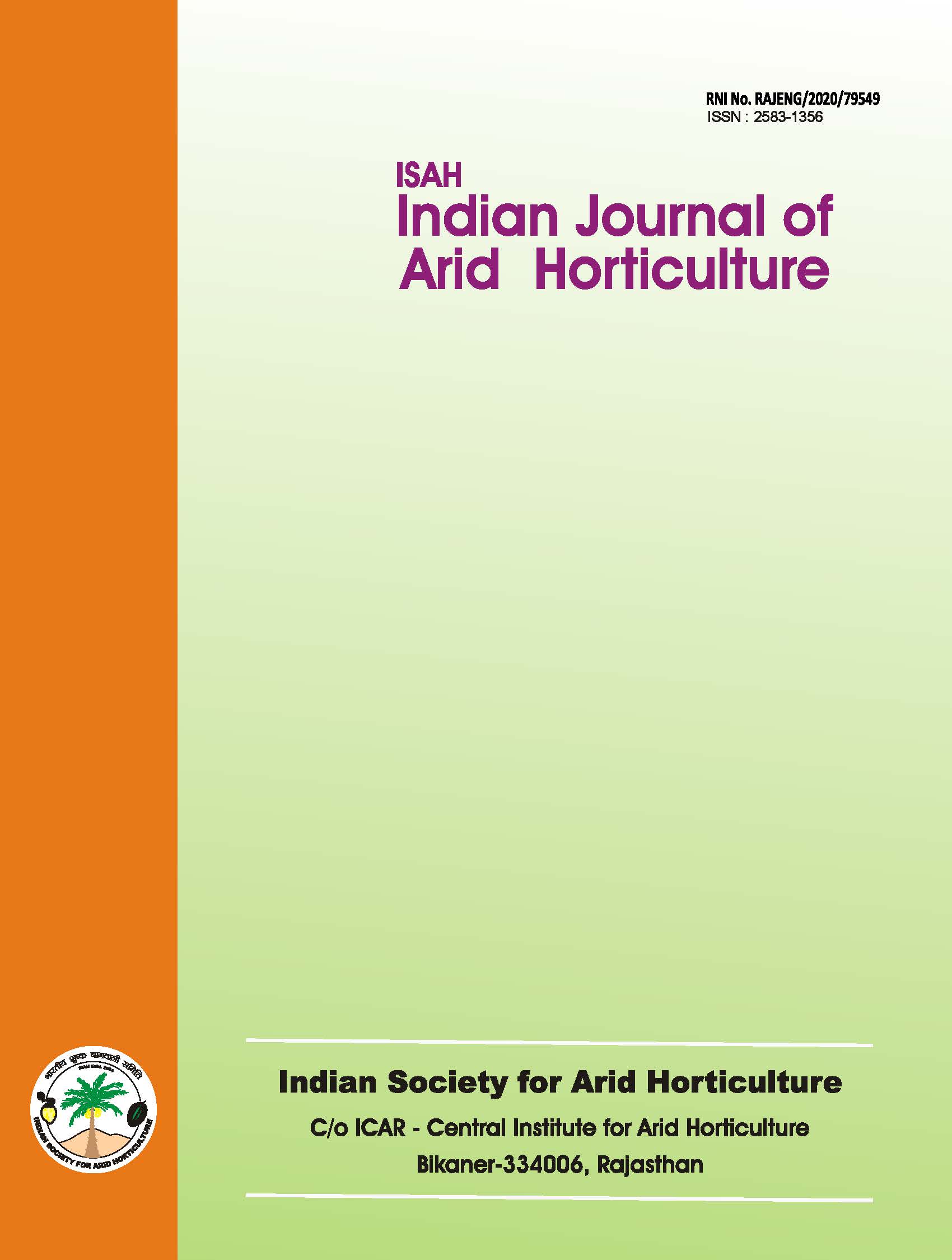Study on physico-chemical properties of aonla (Emblica officinalis Gaertn.) cultivars during fruit growth and development
Keywords:
Aonla, growth, development, physico-chemical characteristic.Abstract
To evaluate the aonla cultivars in Chhattisgarh the physico-chemical characters of eight aonla cultivars viz. Banarasi, Chakaiya, Francis, Kanchan, Krishna, NA-6, NA-7 and NA-10 were studied. Significant variation in average weight, volume, length, diameter and stone weight of different cultivars were found coupled with a similar variation in their contents of TSS, acidity, ascorbic acid and total sugars. Among the physical characters at maturity the maximum dimensions of fruit weight, fruit volume, fruit diameter, fruit length and stone weight respectively were possessed by the cvs. Banarasi (57.74 g), Krishna (57.97 ml), NA-7 (4.38 cm), Banarasi (4.76 cm) and Krishna (5.03 g). Similarly, among the chemical characters at maturity the maximum chemical content of TSS, acidity, ascorbic acid and total sugars respectively were possessed by the cvs. Banarasi (15.71%), Banarasi (2.32%), Banarasi (882.11 mg/100g of pulp) and Krishna (8.23%). Thus, from the overall physical characteristics point of view the cv. Banarasi may be declared to be of best fruit size (fruit weight = 57.74 g, fruit volume = 56.68 ml, fruit diameter = 4.10 cm, fruit length = 4.76 cm) followed by Krishna, Kanchan, Chakaiya and Francis, with the fruit of most inferior size to be the cv. NA-6. Similarly, from the chemical characteristics point of view, the best chemical composition at maturity may be attributed to Banarasi (TSS= 15.71%, acidity = 2.32%, total sugars = 8.09%, ascorbic acid = 882.11 mg/100g of pulp) followed by the cvs. Chakaiya and Francis. However, no single cultivar stands out to be of most inferior chemical quality.Downloads
References
A.O.A.C. 1980. Official methods of analysis. Association of official analytical chemicals. 12 Ed. Washington, D.C. Anonymous. 1965. Agriculture in Ancient India. Ray
Chaudhari, SPP (Tech. Ed.), ICAR, New Delhi. Asenjo, C. F. 1953. The story of West Indian Cherry. Buletin
del Calegio de Qumicos de Puerto Rico, 10: 8-10.- Bajpai, P. N. 1963. Studies on the bearing habit of aonla
(Emblica officinalis Gaertn, Syn. Phyllanthus emblica L). Doctoral thesis, Agra University, India.
Bajpai, P. N. 1965. Studies on vegetable growth and development of male and female genotype in aonla (Emblica officinalis Gaertn.). Agra Univ. J. Res. Sci., 14:167-186.
Bajpai, P.N. 1969. Seasonal variation in Vitamin 'C' content of aonla fruits. Horticultural Advances. 8: 15-16. Firminger, T.A. 1947. Firminger's manuals of gardening for
India, 8th Ed. Thacker Spink and Co. Ltd. Calcutta. Lane, J.H. and Eynon, L. 1960. Determination of sugars by Fehling's solution with methyl blue as an indicator. Journal of Science and Chemistry of India, 42: 327-329.
Mortan, J.F.1960. The Phyllanthus emblica L. Ecological
Botany. 14: 119-127.
Mukherjee, P.K. 1959. Bio-chemical and physiological studies during development of Mango fruits. Horticultural Advances. 3: 95-101. Pathak, R.K.1965. Studies on Physico-chemical changes of aonla (Phyllanthus emblica Linn) during fruit
development. Thesis submitted for the Master of Science in Agriculture (Horticulture) to Agra University, India.
Pathak, R.K., Hariom, Pandey, S.D. and Singh, I.S. 1985. Survey, Classification and Identification of promising strains of aonla (Emblica officinalis Gaertn.) paper presented at 3rd annual workshop held at Rahauri on Arid zone fruits.
Pillay, P.P. and Mahadeva, I. 1958. A chemical experimentation of Emblica officinalis Gaertn. Current Science. 27: 266-267.
Ram, S. 1974. Aonla tree you must grow. International
Agriculture, 12:6-8.
Singh, Prabhakar and Singh, I..S. 1995. Physico-chemical characteristics of fruit in two cvs. of aonla
(Phyllanthus emblica Linn.). Haryana Journal of Horticultural Science. 13 (3-4): 133-134. Snedecor, G.W. and Coachran, W.G. 1967. Statistical methods (Sixth edition). Oxford and IBH Publishing Co. New Delhi, Pp 325-330. Teaotia, S.S., Singh, D.B., Singh, R.D. and Singh, R.N. 1968. Studies of some varieties of aonla of eastern U.P., Punjab Horticulture Journal. 8:241-244. Udai Raj 1994. Studies on the changes in nutrients and bio-chemical constituents during growth and development of fruit in aonla (Emblica officinalis Gaertn.) cv. NA-7. Thesis submitted for the Master of Science in Agriculture (Horticulture) to NDUAT, Faizabad, U.P.

